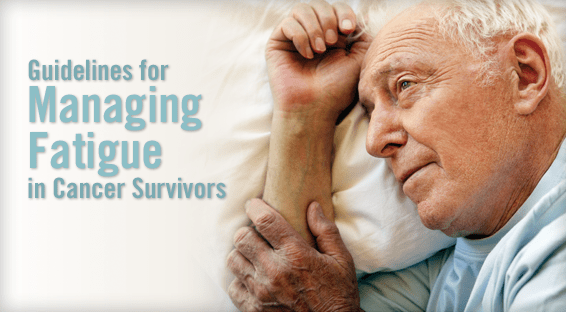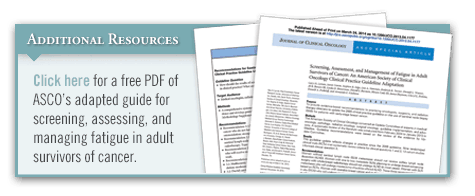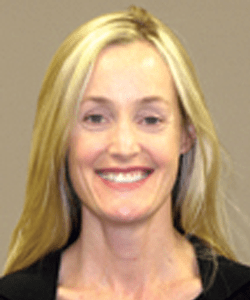With recent advances in cancer screening and treatment, the number of cancer survivors in the United States has increased substantially in recent years. The American Cancer Society estimates that there are about 13.7 million cancer survivors in the U.S., and this figure is expected to rise to nearly 18 million by 2022. Over the years, the Cancer Survivorship Committee of the American Society of Clinical Oncology (ASCO) has issued evidence-based clinical practice guidelines, assessment tools, and screening instruments to help identify and manage late effects of cancer and its treatment. Recently, ASCO released a guideline for managing survivors who experience symptoms of fatigue after completing primary cancer treatment.
The practice guideline pertains to cancer survivors diagnosed at age 18 or older who have completed treatment with curative intent and are in clinical remission without the need for therapy. It is also applicable to patients who are disease free and have transitioned to maintenance or prophylactic therapy. Examples of these patients include breast cancer survivors receiving hormonal therapy and people with chronic myelogenous leukemia receiving tyrosine kinase inhibitors. ASCO’s guidelines are intended to inform all members of patients’ healthcare team as well as patients, family members, and caregivers of cancer survivors.
Fatigue Is a Common Problem
“Many cancer survivors will experience some level of fatigue during their course of treatment,” explains Julienne E. Bower, PhD, who was co-chair of the ASCO writing group that developed the guidelines. “About 20% to 30% of cancer survivors deal with persistent fatigue for years after they’ve been treated for cancer. Fatigue is among the most common and distressing long-term effects of cancer treatment and negatively affects quality of life.”
Screen & Assess Patients for Fatigue
According to ASCO, all healthcare providers should routinely screen patients for the presence of fatigue from diagnosis onward. This includes the period after patients complete their primary treatment. “We need to screen all patients for fatigue after their cancer treatment ends,” says Dr. Bower. ASCO recommends that screening be performed and documented using a quantitative or semi-quantitative assessment and provides a list of helpful instruments that can be used.
The guidelines note that patients who report elevated fatigue on screening (scoring a 4 or greater on a 0 to 10 scale) should undergo more intensive fatigue-oriented assessment. Patient assessments should be a shared responsibility of the clinical team, according to the guidelines. When reviewing patient history and conducting physical exams, clinicians are recommended to perform a focused fatigue history and evaluate patients for their disease status as well as treatable contributing factors. Together, the clinical team should decide when referrals to appropriately trained professionals are warranted. A laboratory evaluation should be considered based on the presence of other symptoms and on the onset and severity of fatigue.
Fatigue Management: Treatment Strategies
With regard to treatment, the ASCO guidelines recommend that all patients receive education about fatigue and general strategies for fatigue management (Table). “Initiating and maintaining adequate levels of physical activity may be particularly important,” says Dr. Bower. “Physical activity can reduce cancer-related fatigue after treatment.” Clinicians should also address other medical and treatable contributing factors, such as pain, depression, anxiety, and other comorbidities.
For patients with severe or persistent fatigue, the ASCO guidelines offer recommendations on psychosocial, mind-body, and pharmacologic interventions. Several psychosocial interventions can be of benefit to this patient group, including cognitive behavioral therapy and psycho-educational therapy. “There is also evidence that mindfulness-based approaches, such as yoga, acupuncture, and other interventions, may reduce fatigue in cancer survivors,” says Dr. Bower. With regard to pharmacologic interventions, there is evidence that psychostimulants and other wakefulness agents can help manage fatigue in advanced cancer patients receiving active treatment, but there is limited evidence of their effectiveness in reducing fatigue in disease-free individuals who have completed treatment.
Tailor Approaches for Post-Treatment Fatigue
Follow-up care for cancer survivors is often challenging, especially if patients are dealing with comorbidities and receiving care from multiple providers. “Considering that multiple factors contribute to post-treatment fatigue, interventions should be tailored to each patient’s specific needs based on their type of cancer, treatments received, overall health, and personal preferences,” Dr. Bower says. In particular, several non-pharmacologic treatment approaches have been effective for cancer survivors in clinical research. Care should also be coordinated during transitions to primary care providers or survivorship clinics. “With open communication, we can decrease the burden of fatigue among cancer survivors,” says Dr. Bower. “We can also optimize decisions when determining appropriate management strategies.”




 TimH
TimH